People have always problems with Oriental rug care. A genuine hand knotted Oriental rug will last a very long time if you take a few precautions to protect from premature wear and the most common kinds of damage. Common problems include..
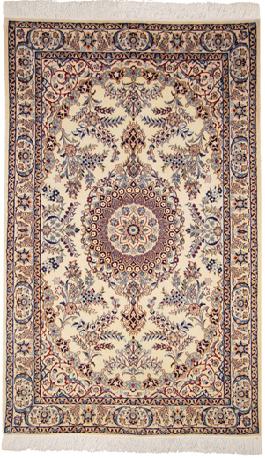
Water Damage
Moth Damage
Carpet Beetle Damage
Dog Chews
Cat Scratchings
Vacuum Cleaner Damage
Chemical Damage
Sun Damage
Uneven Wear
To Move a Rug
To Lay a Rug Flat
Rug Pads
Curled Corners and Curled Edges
Sizing or Blocking a Rug
Storage
Oriental rug care, Water Damage
Most varieties of Oriental rugs have wool pile, but many have cotton warp and weft (the warp is thefoundation upon which knots are tied to create the pile; the weft runs over and under warp strings betweenrows of knots to strengthen the rug from side to side).
This cotton foundation can be weakened, and sometimes actually rotted, if the rug is wetted repeatedly and not properly dried.
A common cause of such damage occurs when potted plants are placed directly on an oriental rug. The plant iswatered regularly, the pot leaks, and the rug under the pot stays permanently damp.
Within two or threeweeks the foundation of the oriental rug can become so weak that chunks can be torn from the affected area byhand. If you use planters near a rug, try to place them on a slim legged stool, or a caster-based support that lets you see under the pot and allows for ventilation.
After watering the plant check to be sure the rug under it is completely dry. It is so important for oriental rug care.. 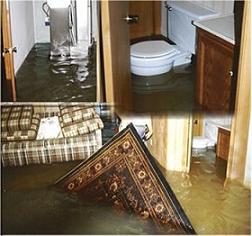 Another form of water damage can affect rugs used in a basement or other area below grade level. If thebasement floods the potential for damage is obvious. The rug must be removed quickly, properly cleaned,and allowed to dry completely.
Another form of water damage can affect rugs used in a basement or other area below grade level. If thebasement floods the potential for damage is obvious. The rug must be removed quickly, properly cleaned,and allowed to dry completely.
A more insidious form of damage can be caused by using a rug over adamp floor (as is often the case if the floor is cement). Even though the floor is not noticeably wet to thetouch, there can be enough moisture to allow microorganisms to flourish in the material of the warp andweft and to degrade the strength of the rug’s foundation.
A rug damaged in this way will often feel peculiarly stiff when manipulated. The rug will sometimes beso stiff it will be difficult to roll, and if you listen carefully to the back of the carpet when it is creased orfolded, you can often hear the cracks and popping noises made by breaking warp and weft fibers.
Oriental rug care, Moth Damage
Flying clothes moths do not eat your rugs, but the females do lay hundreds of eggs each, and the eggshatch into larvae that consume wool, fur, feather, and silk fibers. Moths and their larvae thrive in dark,undisturbed areas where a rug gets little traffic and is not often vacuumed.
A bad infestation sometimesleaves a cobweb-like veil in the area of the damage, along with fine, sand-like debris. An infestation ofteninvolves more than one rug, and can spread to (or from) woolens or furs hanging in a closet or sweatersstored in a drawer.
You can easily care oriental rugs from moths, rug damaged by moths is not difficult to repair, but reweaving a large area of the rugcan be expensive.
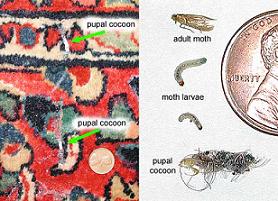 To identify the presence of moths, look for one ormore of these signs:
To identify the presence of moths, look for one ormore of these signs:
Oriental rug care, flying moths The common clothing moth(tineola bisselliella) is the villain. It’s small,3/8″ long or less, and is usually silvery tan orsoft brown in color. This moth flies slowlybut with a rapid flutter of small wings. If youtry to snatch one out of the air, the clothesmoth folds its wings and drops to the floor.
Bare spots in the pile often moth larvaewill prefer the taste of one color yarn overanother, and so the bare spots may involve some specific colors but not others.
webs white gossamer filaments covering apatch of the rug’s pile (often only presentwith a bad infestation).
cocoons 1/8″ diameter x 1/2″ long slightlyfuzzy cylinders usually the same color as therug’s pile (larvae camouflage their cocoonsto blend in with the color of the wool thatsurrounds them).
larvae in the pile slender, white,worm-like moth larvae about 3/8″ long cansometimes be seen just after hatching, beforethey’ve constructed cocoons. It is the larvaethat actually eat the wool.
sand-like particles down in the pile of therug — this material, often tan or brown incolor, regular in size, and granular in look, isthe excretion of the larvae.
Broken/loose plies where the larvae havechewed through yarn overcasting’s orbindings.
Care oriental rugs against moth damage..
Vacuum the entire face of the rug weekly if possible. At least several times a year, vacuum the backside of the rug and the pad and floor underneath. If the rug is too large to handle, flip the edgesover, and vacuum at least one to two feet in along the borders on the back side of the rug. Thecorresponding areas on the pad and floor should also be vacuumed.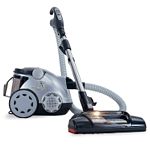
Be aware that moth balls, flakes, or crystals (naphthalene or paradichlorobenzene) are ineffective inmoth control for rugs. These materials act only as a minor repellent to moths. They do not kill mothlarvae, and the naphthalene odor can be unpleasant and difficult to remove from the rug. Cedarscent is useless as a prevention for moth damage.
Any place the vacuum cannot reach, such as areas of the rug under furniture, or a rug hung on thewall, can be sprayed with a household, non-staining insecticide made for the purpose. Most of theseproducts contain pyrethrins (a class of insecticide originally extracted from the flower heads ofchrysanthemums) among the active ingredients.
Although poisonous to many varieties of insects,pyrethrins break down quickly after application and are considered safe for use in the home. BECAREFUL IN CHOOSING AND APPLYING ANY INSECTICIDE.
Choose a product designed for the intended use and follow directions for application, storage, and disposal carefully. If a rug will be stored for a long period see the recommendations on storage.
Oriental Rug Care, Carpet Beetle Damage
Similar in appearance to moth damage, but caused by the larvae of a small (1/8″ long), dark brown or
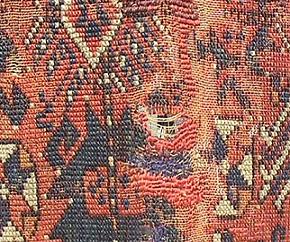 brown-black insect. Beetle larvae damage is usually not as severe, nor as messy as moth damage.Strategies to prevent or treat moth damage will be effective against carpet beetles as well.
brown-black insect. Beetle larvae damage is usually not as severe, nor as messy as moth damage.Strategies to prevent or treat moth damage will be effective against carpet beetles as well.
Oriental Rug Care, Dog Chews
Puppies tend to chew rugs because of tooth growth. The best way to prevent chew damage is to controlthe puppy by keeping it away from the rug. Sometimes sprinkling an ounce of moth flakes under the rugalong the edges will help the dog keep his distance from the rug

Oriental Rug Care, Cat Scratchings
Cats which are not declawed can do significant damage to a rug if they habitually sharpen their claws onit. As with dog chews, the best prevention is to control the cat’s activities. Sometimes a squirt gun (squirtthe cat when it starts to scratch the rug) can be used to condition the cat to avoid the rug.
Oriental Rug Care, Vacuum Cleaner Damage
In almost all instances, regular vacuuming of an Oriental rug with an electric vacuum cleaner is good forthe rug–a dirty rug wears prematurely, and regular vacuuming helps prevent dirt on the surface of the rugfrom filtering down into the pile where it can accumulate and cause increased wear.
Still, be careful witha cleaner equipped with a power brush or “beater bar”; these powered brushes in the vacuum head helpthe vacuum do a good job on machine-made carpeting, but they cause a raking effect on the top layer ofan Oriental rug’s pile if used too strenuously.
If your vacuum cleaner has a power brush, use it onlyoccasionally and lightly on your Oriental rug. For routine cleaning, use just the plain vacuum nozzle. Thisis especially important for fringes; try not to run an upright vacuum or a power brush attachment overfringes.
The brush shreds the fringes and causes rapid wear. Frequently fringes get caught and chewed upby the rotating mechanism of the brush
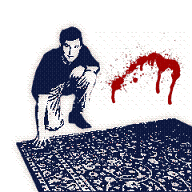
Oriental Rug Care, Chemical Damage
An old trick of some rug cleaners is to bleach the cotton fringe of a rug snowy white before returning therug to the customer (on the theory that if the fringe looks nice and clean, the whole rug looks cleaner).
Unfortunately, chlorine based bleach weakens natural fiber over time. We have seen many rugs with”dead fringe”–fringe so weakened by repeated bleaching s that a tug on the fringe will tear away smallbits. If you must have snowy white fringe, use a dilute bleach solution, and be sure to rinse the fringe verythoroughly.
Oriental Rug Care, Sun Damage
Most rug dyes are quite resistant to sun fading or bleaching. Still, ultraviolet rays are a powerful force ofNature, and a rug will likely fade over time if used for years in a very sunny area. Consider sheer drapesto block some of the direct sunlight, and try to turn the rug end-for-end once a year to even out possiblecolor changes.
Oriental Rug Care, Uneven Wear
A rug should be turned end-for-end once every year or two to even out wear and color change. Try not touse a rug on a very uneven floor. An area of the floor that is raised (a loose floorboard, a transition stripfrom one flooring material to another, etc.) causes the part of the rug that covers it to wear much morerapidly than the rest of the rug
Oriental Rug Care, To Move a Rug
When you move a big rug to adjust its position, there is a better way than just to pull with brute force onthe fringe or edge. A simple trick is to rapidly wave the edge of the rug up and down a foot or two closeto the floor while pulling. This ripple effect sends a cushion of air under the rug, making it very easy tomove.
Oriental Rug Care, To Lay a Rug Flat
If a rug has been folded for shipping, there may be wrinkles or creases when you lay it down. To flattenthem out, first determine which way the nap lays (rub your hand across the pile in the direction of thefringe: the pile will feel smooth one way and will roughen up when rubbed in the opposite direction).
Stand at the end of the rug with the nap running toward you. Roll the rug up from this end as tight as youcan, then slowly unroll and smooth it down along the way. Persistent wrinkles in the same spot can bepressed from the face of the rug using a steam iron on “wool” setting (be sure to iron the pile in itsoriginal direction).
Persistent wrinkles should be attended to, as premature wear along the ridges made bythe wrinkles can result. Some rugs have wrinkles “built in” as the rug is woven–try not to buy one ofthese!
Oriental Rug Care, Rug Pads
For Oriental rug care, rug pads are so useful,Pads under Oriental rugs can prevent sliding, prolong the life of the rug by cushioning the impact betweenshoe sole and hard floor surfaces, and provide comfort under foot. To determine if you need a pad, therule of thumb is: a heavy, thick rug does not necessarily need one, whereas a thin, soft rug does, as does an older rug or a rug that has been rewoven or patched or which has a weakened foundation.
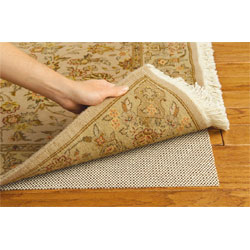
While a padcan extend the life of any rug, whether or not to use a pad under a new rug is often a personal decisionbased upon your preference for the feel of the carpet underfoot. A pad should be about an inch smallerthan the rug all the way around (not counting the fringe) so that the pad will not show beneath the rug.
Pads can be made of materials like rubber, felt, polyester, or one of a number of synthetic foams. For a number of years we have preferred pads for larger rugs made of a polyester felt about 3/8″ thick.
Thismaterial is quite dense and is mechanically strong. We have seen rubber pads crack and crumble aroundthe edges with time, and occasionally rubber pads will become gummy and stick to an older floor finishor even to the back of the rug.
Many of the synthetic urethane foam pads seem too soft and lightweight toprovide much support to the rug.
Oriental Rug Care, Curled Corners and Curled Edges
Because of the way it is woven, a rug may have corners and/or edges that tend to curl under. Straightenthem out when you lay the rug down. If the edges curl badly, the rug may need the attention of a good rugrepair person. Using a rug with badly curled-under edges or corners causes unnatural wear patterns thatcan damage the rug and be difficult to repair properly.
Oriental Rug Care, Sizing or Blocking a Rug
When a rug is out of square or has built-in wrinkles, sizing or blocking may help. A rug is sized byturning it over, making it as square and flat as possible, and fastening it down along the edges (i use a hammer).
A mixture of sizing and water is sprinkled over the back of the rug, and the rug isallowed to dry. The moisture in the sizing helps equalize tension in the foundation of the rug, and thesizing helps the rug hold its square, flat shape. Note that even a good quality rug is rarely perfectlyrectilinear.
When blocking a rug the choice is sometimes between getting it flat or making it square–fromthe standpoint of what’s good for the rug, it is almost always better to make the rug flat than to make itperfectly rectilinear.
Used with care and when appropriate, sizing makes a rug more attractive and usable. Used incorrectly,blocking can distort or even damage a rug.
Over-aggressive blocking will not remedy the problems of abadly crooked or poorly woven rug. Don’t try this at home! Sizing is definitely a process best handled byan experienced dealer or rug repair person.
Oriental Rug Care, Storage
When a rug is to be stored for more than a few months it should be cleaned, sprayed with insecticide, andwrapped in protective plastic or a tough synthetic paper like “Tyvek”� building paper.
Don’t usenewspaper or common brown wrapping paper. These materials are not chemically stable (they are usuallyquite acidic), and do not provide the protection from insects or moisture the stored rug needs. Make surethe rug is completely dry.
Think twice about using moth balls or flakes–these materials have littlerepellent effect, and the odor they impart to the rug can be difficult to remove. Cedar scent is useless inmoth control.
Store the rug in a clean, dry place out of the reach of squirrels or other rodents. Periodicinspection of the rug is strongly recommended
Return from Oriental Rug Care to Persian Rugs